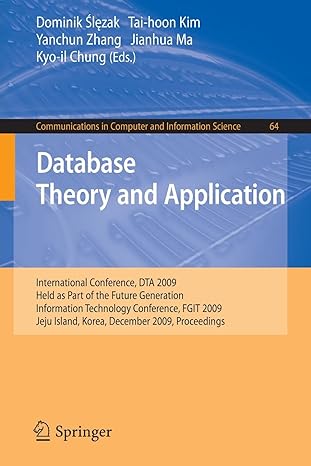Question
Cryptography is an ancient study of secret writing. There is a wealth of literature in this field. An extremely readable book on this subject is
Cryptography is an ancient study of secret writing. There is a wealth of literature in this field. An extremely readable book on this subject is The Code Book by Simon Singh. This is a field of study that is of particular relevance in Computer Science. Given the widespread use of computers, one of the things people are interested in is making transactions over the internet more secure.
Here is a simple and clever way to encrypt plain text. Assume that the message contains only upper case letters, lower case letters and digits. Let L be the length of the original message, and M the smallest square number greater than or equal to L. Add (M-L) asterisks to the message, giving a padded message with length M. Use the padded message to fill a table of size K x K, where K2 = M. Fill the table in row-major order (left to right in each column, top to bottom for each row).
Now to encrypt, rotate the table 90 clockwise. The encrypted message comes from reading the message in row-major order from the rotated table, omitting any asterisks and maintaining the case of each character from the original message.
Let us say the original message is gonewiththewind. The message length L = 15 and so M = 16. The padded message is gonewiththewind*. Here are two tables showing the padded message and the padded message after rotation.
Original Padded Message
| g | o | n | e |
| w | i | t | h |
| t | h | e | w |
| i | n | d | * |
Rotated Padded Message
| i | t | w | g |
| n | h | i | o |
| d | e | t | n |
| * | w | h | e |
So the encrypted message (ignoring the asterisks) is itwgnhiodetnwhe.
Decrypting a message would just be the reverse process of encrypting. Let us consider the encrypted message osotvtnheitersec.
Original Encrypted Message
| o | s | o | t |
| v | t | n | h |
| e | i | t | e |
| r | s | e | c |
Rotated Message 90 Counter Clockwise
| t | h | e | c |
| o | n | t | e |
| s | t | i | s |
| o | v | e | r |
So the decrypted message is thecontestisover.
Input: You will read from standard input. The first line is a string P (1 length ( P ) 100) that you will have to encrypt according to the following scheme. The second line is a string Q (1 length (Q) 100) that you will have to decrypt. Assume that both strings have only upper case letters, lower case letters, and digits. Here is the format of your input cipher.in:
gonewiththewind osotvtnheitersec
You will read your input from stdin like so:
Mac: python3 Cipher.py < cipher.in Windows: python Cipher.py < cipher.in
Output: You will print your output to standard out. The first line will be the encryption of string P and the second line will be the decryption of the string Q. This is the format of your output cipher.out.
itwgnhiodetnwhe thecontestisover
The file (Cipher.py) that you will be submitting will have the following structure. You will follow the standard coding conventions in Python.
# Input: strng is a string of 100 or less of upper case, lower case, # and digits # Output: function returns an encrypted string def encrypt ( strng ): # Input: strng is a string of 100 or less of upper case, lower case, # and digits # Output: function returns an encrypted string def decrypt ( strng ): def main(): # read the two strings P and Q from standard imput # encrypt the string P # decrypt the string Q # print the encrypted string of P and the # decrypted string of Q to standard out if __name__ == "__main__": main()
Step by Step Solution
There are 3 Steps involved in it
Step: 1

Get Instant Access to Expert-Tailored Solutions
See step-by-step solutions with expert insights and AI powered tools for academic success
Step: 2

Step: 3

Ace Your Homework with AI
Get the answers you need in no time with our AI-driven, step-by-step assistance
Get Started


